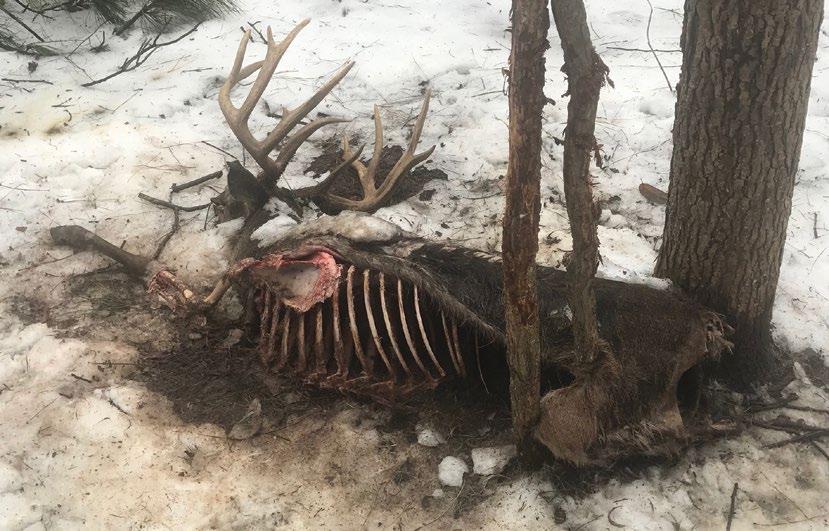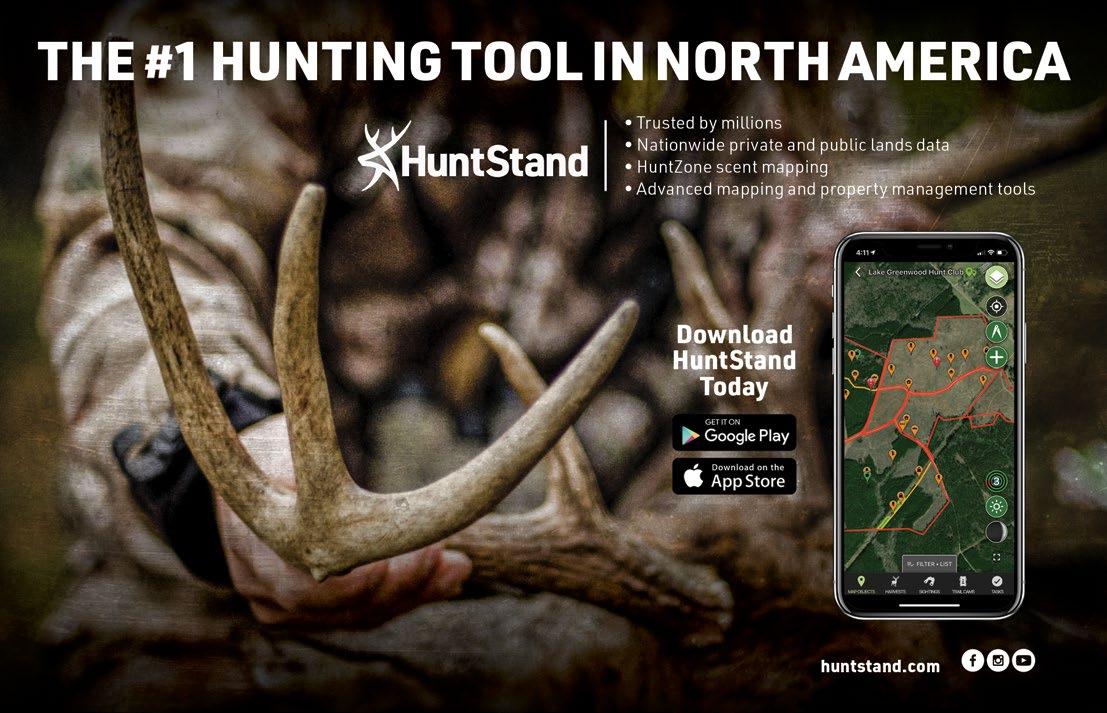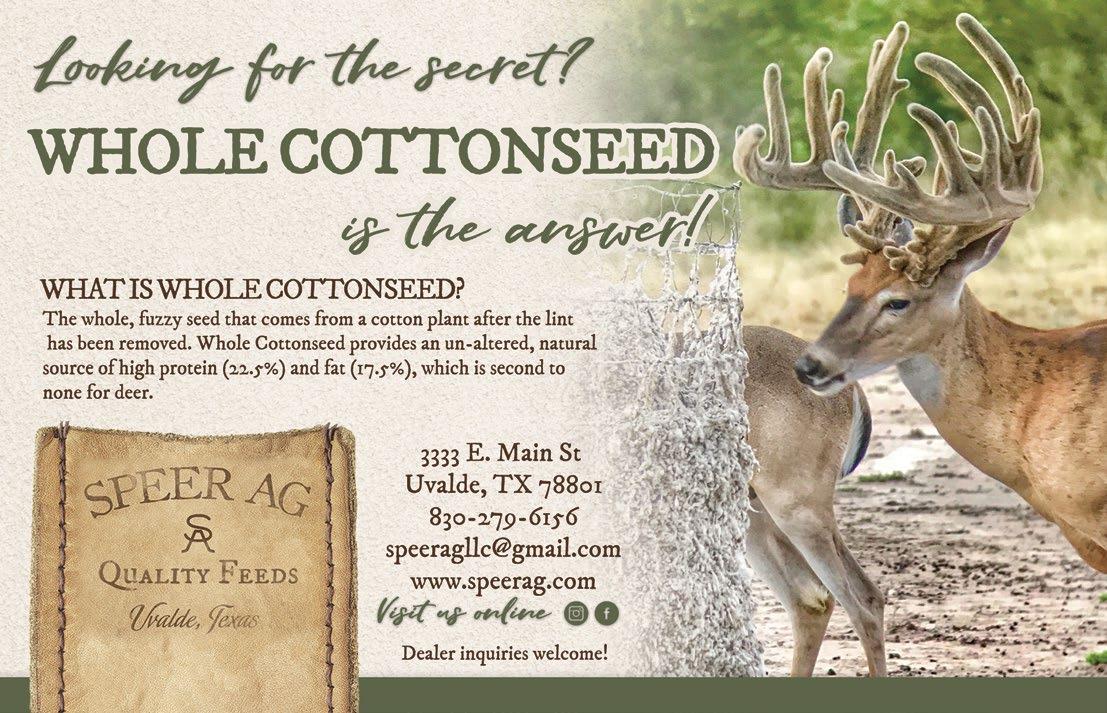
7 minute read
Dr. Deer’s Prescription
Buck Mortality By Dr. James C. Kroll
In the early 1970s, I began presenting seminars in response to the growing demand for information about managing white-tailed deer. By today’s standards these talks were pretty generic, covering the usual age, nutrition and genetics components to management. It was my opinion the greatest challenge was getting bucks past their first year of life.
“Can I safely say, every Boone and Crockett buck once was a yearling?” was my favorite question. To my surprise, the most common response was, “If I don’t shoot him, someone else will!” I would come back with, “Well, if you let a yearling buck walk, his chances were certainly higher than if you shot him!”
That is indeed true, but at that time we had no idea what the true survival rate was for bucks. In Texas, we tend to have opinions on deer management colored by what I call the South Texas mindset. That is, deer management takes place on large properties. In the “real world,” however, folks are trying to manage for better bucks on 40-acre and 80-acre tracks. After 50 years, we now have more data on factors affecting buck survival, so this column is about what we know.
I just finished an exhaustive investigation on the state of knowledge about buck mortality factors, rates and survival. It is an understatement to say the literature is very confusing on these subjects. There are a host of variables influencing mortality, ranging from climatic conditions to hunting pressure to social norms for hunters. In “natural herds,” buck morality takes a “U-shaped” form, with highest death rates in the early and late periods of life.
In general, most studies agree the highest mortality of bucks and does is from birth to about one month of age. There is a reason why does have two fawns. It’s the magic number needed to produce at least one fawn each year. The primary causes, in order, for fawn mortality are starvation, predation, and disease. Under poor nutrition, does cannot produce enough milk to feed both fawns, leaving one or both to die. Fawn survival in 2020 for much of South Texas was quite low, due to very dry conditions, which translated to poor quality and quantity of forages.

According to author, the principal mortality agents for bucks has been disease, fighting and accidents. In 2020-21, he lost two mature bucks to accidents where he conducts deer research. This buck died during the February “snowmageddon” when the deer tried to walk between two trees, got his hips caught, and froze to death.

In other areas of the country, fawn survival was very high due to abundant rainfall during the nursing period.
Predation is a hot topic today, and it should be! Predators are increasing at alarming levels—especially the larger predators such as lions and bears—creating an “additive” impact on survival. Bears can take as much as 50% of the fawn crop, because they are highly adapted to finding fawns, even in thick cover.
It is reported that sheep and goat ranching in the Texas Hill Country allowed the coyote to cross the Edwards Plateau and invade the southeastern and eastern portions of the U.S. Coyotes have moved farther and farther north in the last two decades, creating concern among biologists who once asserted that coyotes were not a real problem. Disease can be a significant problem, especially in conjunction with poor nutrition. Bacterial and viral diseases are common killers of fawns, followed by parasites such as pinworms.
The second highest natural mortality period, especially bucks, is the first year after weaning. However, mortality is not uniform among bucks and does. The reason being that yearling bucks tend to relocate, exposing them to strange places and increased mortality. That is one reason young bucks tend to “pal up” with another buck one year older, in a tight relationship lasting as long as both survive. Most of the scientific studies have focused on mortality of younger bucks, frankly because in many states there are no mature bucks to study.
After a buck reaches his second year, natural mortality is quite low, sometimes less than 5-10%, and I often have said that after 21⁄2 years, a buck is pretty much immortal until 61⁄2 years and older. In fact, an Oklahoma study concluded “… males >3.5 years old tended to die from non-human causes (e.g., fighting, predation) more frequently than did younger deer.” (Ditchkoff, et al. 2001). The key word here is “natural,” because in most of the whitetail’s range, the number one mortality agent after the first year is hunters. Many areas exist where hunters annually take as much as 50% of the yearling bucks.
That trend has lessened in recent years, primarily due to the education of hunters by media such as this magazine, conservation organizations such as the Quality Deer Management Association—now the National Deer Alliance—and outdoor programming. According to QDMA, yearling buck harvest has dropped from a high of about 60% in 1989 to 30% in 2018. Even so, states such as Wisconsin, Maryland, Massachusetts, New York, and Illinois harvested 40-50% of their yearling bucks in 2018. It is interesting that Wisconsin considers any buck greater than 18 months of age, as an “adult.”
It also is a state which considers yearling bucks with spikes less than 5 inches in length. When we consider just bucks, hunters in many areas are indeed the primary mortality agent. Yet, studies conducted in states with high buck harvest rates tell us little about the question, what is a buck’s potential survival if I do not shoot him as a yearling?
In order to arrive at an answer, we have to look at the handful of studies conducted on either un-hunted populations or ones where age management is deeply ingrained. The five states with the highest percentage of 31⁄2+ year old bucks in the harvest are Mississippi (77%), Louisiana (75%), Arkansas (72%), Oklahoma (66%), and Texas (65%), all states where management is very popular. Texas probably is number five due to there being more dyed-in-the-wool trophy hunters, willing to let even middle-aged bucks walk.
The Oklahoma study referenced earlier reported annual mortality for older bucks to be 0.26-0.38 annually, with most mortality coming from non-hunting factors. Bowman, et al. 2007 reported on a study on managed herds in Mississippi, concluding “… if <2.5-year-old bucks are passed up … will be available for harvest during the next season because these bucks have very little natural mortality.” In South Texas, a study by Hewitt and Hellickson, on an intensively managed ranch, reported, “Average annual survival of the known-aged 1998 cohort was 82% with 52% of [bucks] surviving to 6.5 years of age.”
There is almost nothing known about un-hunted deer herds. The only information we have about natural deer herds comes from studies on the middens (trash piles) of Native Americans. According to one study (Elder, 1965), 20-26% of deer killed by Native Americans were 61⁄2 years or older. For such a high percentage of bucks to reach that age, annual mortality has to be very low.
Finally, at our research facility near Nacogdoches, for 38 years we have harvested only a handful of bucks. In those years, the principal mortality agent for bucks has been disease (hemorrhagic and pneumonia), fighting and accidents. It is amazing how many accidents deer have. In 2020-21 we lost two mature bucks to accidents, one during the February “snowmageddon,” when it tried to walk between two trees, got its hips caught and froze to death.
The answer to the question about what happens to a young buck if you let him walk, is clear in my mind! He has an acceptable chance of reaching an older age when he will have the largest antlers his genetics will permit. This is true even in areas where landholdings are small. So, there is no excuse for not passing on yearling bucks, provided hunters are willing to do just that. But that is a topic for another column.

CITED SOURCES Bowman, J. L., H. A. Jacobson, D. S. Coggin, J. R. Heffelfinger, and B. D. Leopold. 2007. Survival and Cause-specific Mortality of Adult Male White-tailed Deer Managed Under the Quality Deer Management Paradigm. Proc. Annu. Conf. Southeast. Assoc. Fish and Wildl. Agencies 61:76–81
Ditchkoff, S. S., E. R. Welch, Jr., E. R. Lochmiller, R. E. Masters, and W. R. Starry. 2001. Age-specific causes of mortality among male white-tailed deer support mate-competition theory. J. Wildlife Management 65(3):552-559.
Webb, S. L., D. G. Hewitt, and M. W. Hellickson. 2007. Survival and Cause-Specific Mortality of Mature Male White-Tailed Deer. J. Wildlife Management 71(2):555558.
Elder, W. H. 1965. Primeval deer hunting pressures revealed by remains from American Indian middens. J. Wildlife Management 29(2): 366-370.












